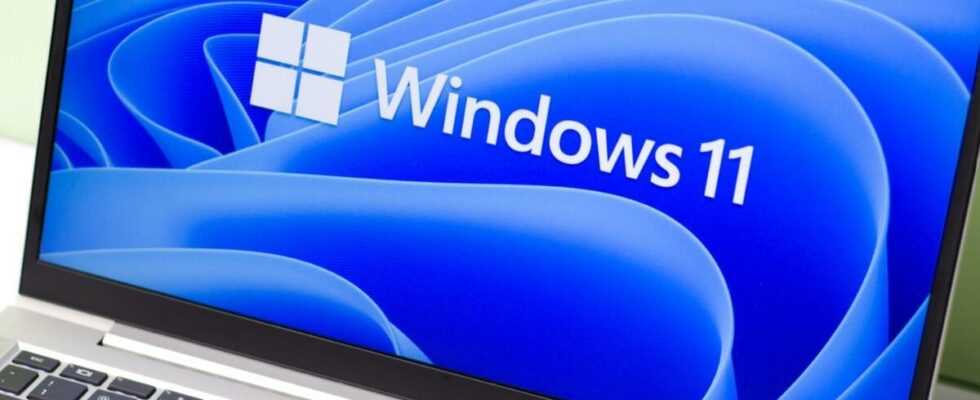Here we go again. A small IT management company, Lansweeper, is trying to boost its notoriety by issuing yet another press release about the adoption of Windows 11. The title is a delight for tech journalists: “More PCs running Windows XP than Windows 11”.
A title like this is a real magnet for the press in need of traffic.
The numbers themselves are literally unbelievable. According to the company’s press release, only 1.44% of PCs are running Windows 11 as of April 2022, six months after the release of Microsoft’s latest operating system. In addition, 6.6% of computers operate under “end-of-life operating systems”, mainly Windows XP and Windows 7.
So it would be a spectacular failure for Microsoft if these numbers were indicative of Windows 11’s actual adoption rates. But closer examination suggests that these numbers don’t prove much.
For starters, where does the data come from? According to a footnote in the press release, the company “scanned 10 million Windows PCs from a mix of Lansweeper (20% enterprise) and Fing (80% consumer).”
So, let’s break that down. Lansweeper is an asset management tool designed to identify all “assets” on corporate networks, including servers, routers, workstations, printers, displays, and associated software. Fing, which was acquired by Lansweeper in 2020, manufactures its own network scanner and says its “device recognition and fingerprinting technologies provide visibility across the entire digital, consumer, and business environment.” IoT [internet des objets] industrial to OT [Operational Technology] “.
A network-oriented sample
None of these products are exactly the kind of scan tools one is likely to find in the typical consumer’s home. You need to be a network admin, or at least play one in your local domain, to use this stuff.
The nice chart that accompanied this press release contains some additional red flags. First, 9.15% of sampled Windows devices use Windows Server products. None of them could benefit from an upgrade to Windows 11, and it wouldn’t make sense to replace a server OS with a workstation OS.
Also, according to another nice graph, this one on a company blog post, about 9% of workstations didn’t meet the minimum RAM requirements for Windows 11. Seriously? That figure is pegged at 4GB, which is standard for all consumer PCs sold for at least seven years. If that number is to be believed, that means at least one million of the 10 million workstations studied are running on just 2GB of RAM.
A possible explanation is buried in another confusing paragraph, which mentions in passing that only about two-thirds of virtual machine desktops have enough RAM to meet Windows 11 standards. purchase additional hardware to increase a virtual machine’s RAM (just change a setting in the virtual machine’s configuration file).
There’s not really enough data to know what all of this means, but it seems this sample is much more geared towards enterprise networks: lots of dedicated industrial IoT applications and OT controllers on workstations. physical and virtual workplaces that don’t need the kind of hardware found in a consumer or small business PC.
So what percentage of the installed base of PCs today actually uses Windows 11? Microsoft may know this, but is not saying it. The latest figure I found on the company’s site was “1.4 billion monthly active devices running Windows 10 or Windows 11.”
One of the problems anyone trying to measure device populations has is that Windows 11 and Windows 10 both come with similar version numbers. An up-to-date installation of Windows 11 has version 10.0.22000.613, while the latest version of Windows 10 is version 10.0.19044.1586. It is therefore difficult for web-based analysis frameworks to tell the difference. Indeed, the US government’s data analytics program, for example, shows that 93.55% of its traffic over the past 90 days (representing 1.8 billion visits from Windows devices) came from devices running Windows version 10; there is no separate traffic figure for Windows 11.
This company is not the first to try to restore its image by brandishing figures of dubious origin. Last month, a Windows ad network released a press release claiming Windows 11 adoption rate was ridiculously high at 19.3%.
The main driver of Windows 11 adoption will, of course, be sales of new PCs. OEMs sold more than 150 million new PCs in the six months since the release of Windows 11. It’s safe to say that most consumer PCs came with Windows 11 pre-installed, while the Most business PCs came with Windows 10. Either way, that’s tens of millions of new Windows 11 PCs. Companies typically upgrade by replacing hardware, not allowing employees to download upgrades from Microsoft servers.
If history is any guide, these PC replacement cycles will push Windows 11’s installed base to roughly equal status with Windows 10 in about three years. But you won’t learn that from a press release.
Source: ZDNet.com
